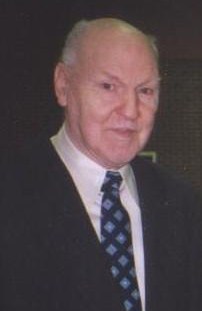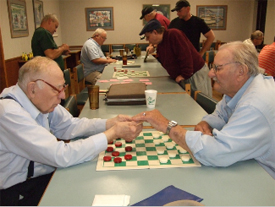|
|
Grandmaster Elbert L. Lowder
|
The game of checkers has a proud lineage but, unlike its “cousin-in-law,”
chess, it has remained a sport enjoyed by many different kinds and ages of
people. Today, the average tournament checker player is fifty-seven, but
North Carolina, as well as national checkers groups, is encouraging schools
to engage their students in this sport that requires thought,
problem-solving, and visual concentration. The late 1990’s brought a renewal
of interest and the growth of Internet play.
Dating from the earlier Pharaohs, checkers is mentioned by Plato and Homer.
Likely, it was imported from Greece by the Romans and from the Moors of
Arabia by the Spanish. Antonio Torquemada, of Valencia, Spain, wrote the
first book (published 1547) about the game. In 1650 came Juan Garsia
Canalejas’ work with games and “traps” that remain viable. Middle Eastern
Alquerque or Quirkat may have parented English “draughts,”
our checkers. Mathematician William Payne’s Guide to the Game of
Draughts appeared in 1756, with a dedication by Samuel Johnson. It was
followed, in 1800, by Joshua Sturges’ treatise, which served as a textbook
for almost half a century. Hundreds of books on the subject were available
by 1900. Poe declared “the higher powers of the reflective intellect . . .
decidedly and more usefully tasked by the unostentatious game of draughts
than by all the elaborate frivolity of chess.”
The United States played its first team match with the British in 1905.
Interest in checkers peaked from World War II to the early 1950’s.
The first settlers in North Carolina brought the game with them, and matches
between its top players date from the late 1800’s, with the State Checker
Tournament among its oldest competitive events. With the exception of
1943-1945, North Carolina has crowned a champion annually since 1890.
Sanford is a popular gathering place for checkers and checker players and
was the home of Grandmaster Elbert L. Lowder from 1960 until his death (14
December 2006). He was a bachelor not much interested in fashion (though
there was that “dazzling plaid knit blazer”!) and is captured above in a
rare appearance in a suit. Known world-wide for his championship titles and
his brilliant and creative play, he owned and operated “The Piano House”
with his business and checkers partner, Tim Laverty (who won the 2008 Elbert
Lowder Memorial 11-Man Ballot Checkers National Tournament). Lowder sold,
serviced, and moved all kinds of pianos; but his specialty was rebuilding
the Pianola player piano. He was recognized as one of the best in the
business for his craftsmanship in restoration and his conversion techniques.
He used a vacuum cleaner motor to convert the foot-powered bellows mechanism
to an electric pump system.
Lowder made his living through his piano business, but his first love was
checkers. He began playing at sixteen and won his first North Carolina State
Tournament (Winston-Salem, 1952) when he was twenty. He dominated North
Carolina checkers for over fifty-four years and won the State Title
thirty-four times. He was US National Three-Move Champion in 1992 and won
three National Go-As-You-Please [GAYP] Championships (1977, 1987, 1993). He
played in International Checker Tournaments, was a member of the US Team
when it played the United Kingdom and Ireland, played World Championship and
World Title Matches, and won numerous lesser titles.
Another name closely associated with checkers and its promotion in Lee
County, for some fifty years in fact, is auctioneer and businessman Clinton
C. (“Clint”) Pickard. District 4 manager for the American Checker Federation
for many years and Treasurer of the North Carolina Checker Association
(eighteen years), he has hosted numerous area, ten state, and four national
tournaments (1976, 1977, 1979, 1981). Key helpers were Lowder, Ray Brooks,
Sion Kelly, and Attorney H. M. Jackson.
The North Carolina Checker Association (founded 1918) is affiliated with the
American Checker Federation [ACF], the central governing body for checkers
in this country, with the purpose of both to organize, promote, and sponsor
checker tournaments. It was “rejuvenated” and secured non-profit status in
1987, with Clint (Treasurer) the chief promoter of the reorganization and
changes and Lowder as Secretary. Clint’s efforts to keep checkers
established in North Carolina are considered virtually miraculous.
The last state tourney in the area (2007) was held at The River Lodge and
Palomino Motel in Sanford; and Clint, Lee County Centennial Committee
Vice-Chair of Fundraising, tied it in with the celebration. He also led the
effort to have “In Memory of Elbert Lowder, Checkers Champion: State (34
Times), National (4 Times)” placed on the plaque honoring Centennial donors
(on permanent display in the Government Center).
The 120th continuous state tournament is May 14-15 at the Days Inn in Siler
City.
Above, Clint (left) and Greensboro’s Bill Stanley (85 and 88, respectively)
start their fifth-round match (2010) by drawing ballots for the opening
moves of the first three (restricted). Professional checker tournaments have
156 possible openings, each of which has a weak or disadvantaged opening
position. Players try to draw the weak side and win the strong side when
they have it. Each gets to play both sides. One holds a checker in each
hand; the opponent chooses and plays the color picked, playing the other
color in the next game. The aim is to reduce “draw games.” Otherwise, when
players have a pat game and play each other often, they learn most of their
opponents’ moves and countermoves. Like chess, checkers, for opponents
generally equal in skill, knowledge, and visualization, is “drawish.”
The “Grand Ole Game” of checkers is counted a mind sport, a wonderful hobby,
and one of the finest board games ever devised. On rainy days, weekends, and
general “hang-out” days, North Carolinians flocked to the feed mill, grocery
store, gas station, barber shop, hardware store, or even the courthouse to
enjoy it. Railroaders, firemen, farmers, and factory workers played during
breaks and over lunch. Many still do!
Greensboro’s J. R. Smith, Secretary of the North Carolina Checker
Association, contributed “Elbert L. Lowder and Lee County Checkers,” to the
Lee County Centennial book (p. 129) and has provided additional information,
including the pictures, used here. He attended the Reception for and
Dedication of the Plaque Honoring Centennial Donors (4 November 2007) and
maintains the website,
www.nccheckers.org . He remembers
his grandfather making a board, sawing a broom handle into checkers, and
using smut from the fireplace to distinguish one color from the other.



